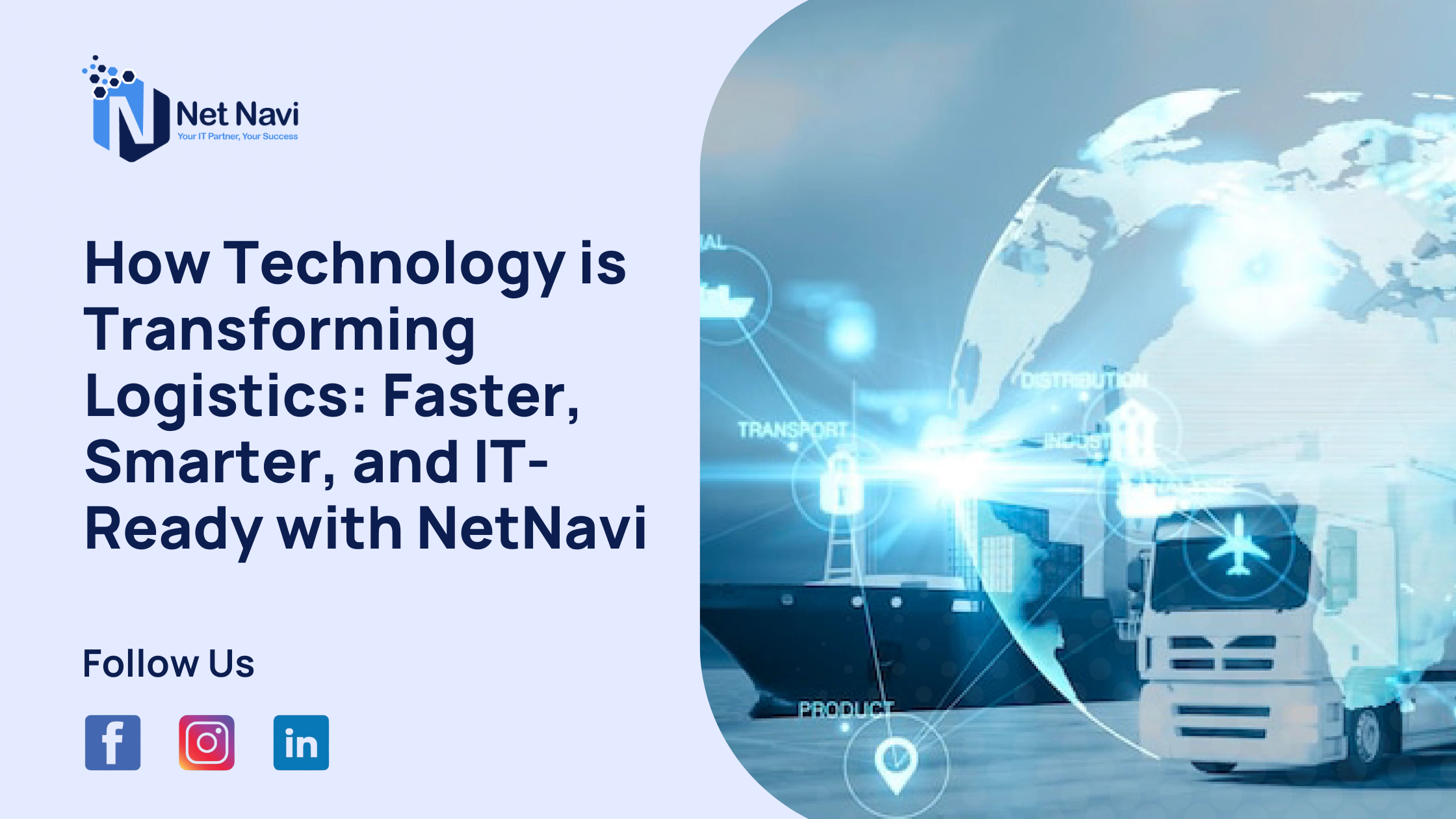Technology makes UK logistics increasingly efficient, saves time, cuts operational costs, and increases the efficiency of delivery. Some key advantages include:
- Automation of warehouse operations to ensure speedier and error-free processing.
- AI-powered route optimization to decrease fuel consumption and time taken for delivery.
- Real-time tracking with IoT devices allows for full supply chain visibility.
- Improved customer satisfaction with correct and timely deliveries
UK businesses using IT support for logistics can scale operations efficiently while maintaining reliability.
Technology in logistics refers to IT systems and various digital means that assure the enterprise of effective and efficient management and control over the flow of goods. Companies in the UK are increasingly relying on IT support throughout their value chains in logistics, from inventory management to route planning and shipment tracking. Tools such as AI, IoT, and automation of warehouses cut delays, reduce costs, and enhance customer service. UK companies will make sure of quicker deliveries, precise stock levels, and scalable operations by integrating these systems in order to meet modern demands across the supply chain.
Logistics is the backbone of how products move from place to place, be it from warehouses, trucks, airplanes, and delivery vans right to the customer’s doorstep. However, logistics is not that easy since there are delays, errors, and other problems with inventories, deliveries, and transportation. That is where technology comes into play.
Logistics within today’s fast-moving world is irredeemably related to technology. Businesses are supposed to use IT solutions in order to make their supply chains faster, smarter, and more reliable. Modern tools support logistics teams from the management of warehouses up to route optimization, enabling them to reduce mistakes, save costs, and provide customers with an improved experience.
It is thus expected that, by 2025, the global logistics market will reach about $11.23 trillion and grow further to as much as $23.14 trillion in 2034, reflecting the growing reliance on technology in managing complex supply chains. In the UK alone, logistics continues to adopt digital solutions to remain competitive.
Improving Efficiency and Reducing Costs
Automation will transform most of the business areas of logistics organizations. For instance, sorting and picking, and even inventory updating, can safely be left to machines and smart software. Besides reducing human errors, this frees up the staff for more value-added functions.
On average, companies using these digital tools reported a short-term efficiency gain of 10–20%, while for others, the increase was 20–40% over two to four years. For the IT support teams in logistics, this means fewer disruptions, quicker problem resolution, and each successive day running more smoothly.
GPS and AI-driven route planning helps decrease fuel consumption and reduces delivery time. Real-time tracking enables the logistics manager to divert the vehicle in real time for traffic or weather delays, or for any issue. As a matter of fact, 50% of transportation and logistics firms have implemented real-time tracking and sensor-based monitoring so far, improving delivery accuracy and increasing transparency.
Improving Accuracy and Quality
Inventory and order fulfillment errors can be very expensive. Advanced WMS systems automate stock handling and update in real time to ensure the products are always accounted for and correctly shipped.
It is one of the fastest-growing areas in which the market is expected to cross USD 30 billion by 2026. Hence, this helps an organization expand its operations without being overly dependent on manual labor and helps them maintain accuracy at high volumes.
AI-powered analytics predict inventory levels and help avoid stockouts to cut down both costs and customer complaints. 55% of supply chain leaders are investing more in technology to focus on maintaining quality with digital solutions.
Real-Time Visibility and Data Analytics
IT systems provide end-to-end visibility of goods in transit. GPS trackers, IoT sensors, and dashboards provide the necessary means to logistics teams to track shipments, predict delays, and thus optimize operations.
The global digital logistics market is estimated at USD 77.52 billion by 2030, indicating how much a firm relies on real-time insights to keep the wheels of efficiency well-oiled. This kind of continuous monitoring allows for proactive problem-solving and prevents small issues from becoming big disruptions.
Data analytics enables predictive capability. Logistic managers can predict demand by analyzing historical trends and, thus, optimize inventory and routing using insights from data analytics. Future trends are AI-driven decision-making and blockchain for supply chain visibility and security.
Improving Customer Satisfaction
Customers expect speed and reliability of delivery. IT in logistics ensures timely shipment, exact tracking updates, and fewer errors. It also enriches customer experience through personalization in notification and proactive issue management.
Real-time tracking and analytics further enable logistics providers to act quickly if there is an issue. Advanced TMS has been used, for instance, by businesses in the Midlands and Manchester, which have reduced fuel costs, streamlined delivery routes, and improved customer satisfaction.
Supporting Sustainability and Scalability
Technology provides efficiency and environmental sustainability. Optimizing routes reduces fuel consumption, automated warehouses consume less energy, and digital documentation cuts down on paper use.
Integration of scalable automation solutions allows this business to expand operations without costs growing linearly. Spending on logistics automation will grow from about USD 65 billion in 2023 to reach USD 217 billion by 2033, showing long-term investment in technology for scalable and sustainable operations.
Role of IT in Logistics
For any form of logistics to operate well, IT support is paramount. IT teams deal with activities that range from troubleshooting over industrial networks to warehouse management systems. With effective IT support, businesses can integrate advanced tools like predictive analytics, AI-powered inventory management, and IoT tracking devices without experiencing downtime.
It allows for real-time collaboration between warehouses, transport teams, and customers, backed by a well-supported IT infrastructure. This minimizes errors, enables timely delivery, and offers actionable insights for continuous improvement.
Future Development of Technologies within Logistics
The logistics industry is changing fast. Emerging technologies such as autonomous vehicles, AI-assisted drones, and blockchain for supply chain transparency are about to change how goods are moved and tracked.
Organisations around the world are investing heavily in technology. In 2024, 80% of companies in the country have already adopted or were planning on new IT solutions to improve logistics. The costs of logistics in India are estimated at ~7.97% of GDP, so there is considerable incentive toward investing in cost-efficient, technology-driven operations.
Companies open to such innovation will see themselves at the threshold of logistics operations that are faster, more reliable, and ‘green’, all to meet the growing expectations of customers.
At NetNavi, our best IT support for logistics ensures your supply chain runs smoothly and efficiently across the UK. From optimising warehouse operations with automation solutions to enhancing fleet performance through AI-powered route planning, our services cover every aspect of logistics IT management. We also provide robust cybersecurity for logistics systems to protect your data and operations. Explore our full range of IT support services to see how we help businesses scale and stay resilient, or check our case studies to see real-world results from UK logistics companies.
Frequently Asked Questions
Why is technology so important for logistics?
It can also make the supply chain fast, accurate, and visible to ensure reduced errors, costs, and delays.
What is the use of technology in logistics?
Applications include route optimization, warehouse automation, tracking inventory, predictive analytics, and real-time monitoring.
How does technology contribute to supply chains?
It greatly improves the visibility, forecasting, and efficiency, essentially the speed with which a business responds to changes in demand.
How does technology benefit transportation?
It offers optimized routes, saves fuel, predicts maintenance, and can even track deliveries automatically. It improves cost efficiency and reliability.
What is the role of IT in logistics?
It ensures smooth operations, system maintenance, and supports the integration of advanced tools and analytics.
What are the responsibilities of an IT logistics manager?
They manage IT infrastructure, support logistics software, monitor system performance, and guarantee operational continuity.
Q1: Where can I find affordable IT support for logistics in the UK?
NetNavi provides the following UK IT support in logistics: effective integration of warehouse systems, route planning, and real-time tracking for businesses of all kinds.
Q2: How does technology make the supply chains of the UK faster?
AI, IoT, and automated inventory systems track the shipment, optimize routes, and handle inventories in real time to reduce delays. Q3: Is it possible for small UK businesses to use AI in logistics? Indeed, affordable AI-powered tools now help small UK companies plot the best routes, track their delivery schedules, and even forecast demand, helping them compete with bigger players.










